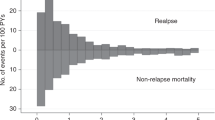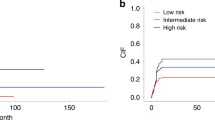Abstract
We report 27 patients with relapsed acute or chronic leukemia who underwent a second hematopoietic stem cell transplant (HSCT) from a related or unrelated donor. Seventeen patients were diagnosed with acute myelogenous leukemia (AML), six with acute lymphocytic leukemia (ALL) and four with chronic myeloid leukemia (CML). Ages ranged from 22 to 49 years (median 37); 13 patients were female and 14 male. Relapse was diagnosed between 1 and 45 months after the first HSCT. Sixteen patients who relapsed had received an autologous transplant initially and 11 an allogeneic transplant. Ten patients relapsed within 6 months and 17 patients later than 6 months. Chemotherapy was used as reinduction for relapse after HSCT in 16 patients who had received an autologous transplant and in three who had received an allogeneic transplant, since the latter did not respond to reduction of immunosuppression to induce a graft-versus-leukemia (GVL) reaction. Five of these 19 patients (26%) achieved complete remission (CR), seven patients did not respond to chemotherapy and seven achieved a partial remission (PR). The stem cell source for the second HSCT included bone marrow (n = 12) and PBSC (n = 4) from genotypically identical unrelated donors, PBSC (n = 7) and bone marrow (n = 3) from related donors. Currently eight of the 27 patients are alive and disease-free after the second HSCT. One patient is alive and disease-free after two allogeneic transplants (day +1538), eight patients, who relapsed after an autologous transplant followed by an allogeneic transplant (days +248 to +1140), acute myeloid leukaemia (n = 6) and chronic myeloid leukemia (n = 2) are alive and disease-free. The overall disease-free survival is 30% (8/27). The overall disease-free survival of autologous transplant patients subsequently undergoing an allogeneic transplant is 43% (P = 0.049). It is suggested that a second HSCT is possible for patients with leukemia relapse following the first autologous transplant. A second transplant might also be offered to patients relapsing after the first allogeneic HSCT. Bone Marrow Transplantation (2000) 25, 41–45.
This is a preview of subscription content, access via your institution
Access options
Subscribe to this journal
Receive 12 print issues and online access
$259.00 per year
only $21.58 per issue
Buy this article
- Purchase on SpringerLink
- Instant access to full article PDF
Prices may be subject to local taxes which are calculated during checkout


Similar content being viewed by others
References
Donney K, Fisher LD, Appelbaum F . Treatment of adult acute lymphoblastic leukemia with allogenic bone marrow transplantation. Multivariate analysis of factors affecting acute graft-versus-host disease, relapse and relapse free survival Bone Marrow Transplant 1991 7: 453–459
Wingard JR, Piantadosi S, Santos WG . Allogeneic bone marrow transplant for patients with high risk acute lymphoblastic leukemia J Clin Oncol 1991 8: 820–830
Gale RP, Kersey JH, Bortin MM et al. Bone marrow transplantation for acute lymhoblastic leukemia Lancet 1983 2: 663–667
Gratwohl A, Hermans J, Barrett AJ et al . Allogeneic bone marrow transplantation for leukemia in Europe. Report from the Working Party on Leukemia. European Group for Bone Marrow Transplantation Lancet 1988 i: 1375–1382
Sierra J, Storer B, Hanser JA et al. Transplantation of marrow cells from unrelated donors for treatment of high-risk acute leukemia: the effect of leukemia burden, donor HLA-matching and marrow cell dose Blood 1997 89: 4226–4235
Barrett A, Locatelli F, Treleaven JG et al. Second transplants for leukaemic relapse after bone marrow transplantation: high early mortality but favourable effect of chronic GVHD on continued remission Br J Haematol 1991 79: 567–574
Atkinson K . Who should get a second marrow transplant? Bone Marrow Transplant 1992 10: 82–84
Martino R, Badell I, Brunet S et al. Second bone marrow transplantation for leukemia in untreated relapse Bone Marrow Transplant 1994 14: 589–593
Wagner JE, Vogelsang GB, Zehnbauer BA et al. Relapse of leukemia after bone marrow transplantation. Effect of second myeloablative therapy Bone Marrow Transplant 1992 9: 205–209
Locatelli F . The role of repeat transplantation of haematopoietic stem cells and adoptive immunotherapy in treatment of leukemia relapsing following allogeneic transplantation Br J Haematol 1998 102: 633–638
Chiang KY, Weisdorf DJ, Davies SM et al. Outcomeof second bone marrow transplantation following a uniformconditioning regimen as therapy for malignant relapse BoneMarrow Transplant 1996 17: 39–42
Tsai, T, Goodman S, Saez R et al. Allogeneic bone marrow transplantation in patients who relapse after autologous transplantation Bone Marrow Transplant 1997 20: 859–863
Kröger N, Hoffknecht M, Hänel M et al. Busulfan, cyclophosphamide and etoposide as high-dose conditioning therapy in patients with malignant lymphoma and prior dose limiting radiation therapy Bone Marrow Transplant 1998 21: 1171–1175
Sierra J, Storer B, Hansen JA et al. Transplantation of marrow cells from unrelated donors for treatment of high risk acute leukemia: the effect of leukemic burden, donor HLA-matching and marrow cell dose Blood 1997 89: 4226–4235
Armitage P, Berry G . Statistical Methods in Medical Research Blackwell Science: Oxford 1987
Mrsic M, Horowitz MM, Atkinson K et al. Second HLA-identical sibling transplants for leukemia recurrence Bone Marrow Transplant 1992 9: 269–275
Blau IW, Basara N, Serr A et al. A second unrelated bone marrow transplant: successful quantitative monitoring of mixed chimerism using a highly discriminative PCR-STR system Clin Lab Haematol 1999 21: 133–138
Sanders JE, Buckner CD, Clift RA et al. Second marrow transplants in patients with leukemia who relapse after allogeneic marrow transplantation Bone Marrow Transplant 1988 3: 11–19
Basara N, Bischoff ME, Blau IW et al. A second unrelated bone marrow transplant with an unrelated donor marrow: treatment of a patient with relapsed leukemia Bone Marrow Transplant 1998 21: 291–293
Champlin R, Giralt S, Gajewski J et al. T cells, graft-versus-host disease and graft-versus-leukemia: innovative approaches for blood and marrow transplantation Acta Haematol 1996 95: 157–163
Kolb HJ, Schattenberg A, Goldman JM et al. Graft-versus-leukemia effect of donor lymphocyte transfusion in marrow grafted patients Blood 1995 86: 2041–2050
Khouri IF, Keating M, Körbling M et al. Transplant lite: induction of graft-versus-malignancy using fludarabine-based nonablative chemotherapy and allogeneic blood progenitor cell transplantation as treatment for lymphoid malignancies J Clin Oncol 1998 16: 2817–2824
Author information
Authors and Affiliations
Rights and permissions
About this article
Cite this article
Blau, I., Basara, N., Bischoff, M. et al. Second allogeneic hematopoietic stem cell transplantation as treatment for leukemia relapsing following a first transplant. Bone Marrow Transplant 25, 41–45 (2000). https://doi.org/10.1038/sj.bmt.1702101
Received:
Accepted:
Published:
Issue date:
DOI: https://doi.org/10.1038/sj.bmt.1702101
Keywords
This article is cited by
-
Second unmanipulated allogeneic transplantation could be used as a salvage option for patients with relapsed acute leukemia post-chemotherapy plus modified donor lymphocyte infusion
Frontiers of Medicine (2021)
-
Treatment of Relapse of Acute Myeloid Leukemia After Allogeneic Hematopoietic Stem Cell Transplantation
Current Hematologic Malignancy Reports (2014)
-
Second allogeneic hematopoietic SCT for relapsed ALL in children
Bone Marrow Transplantation (2012)
-
Allogeneic hematopoietic stem cell transplantation in patients with diffuse large B cell lymphoma relapsed after autologous stem cell transplantation: A GITMO study
Annals of Hematology (2012)
-
Double allogeneic hematopoietic SCT as a rescue therapy for poor-risk hematological malignancies
Bone Marrow Transplantation (2010)



